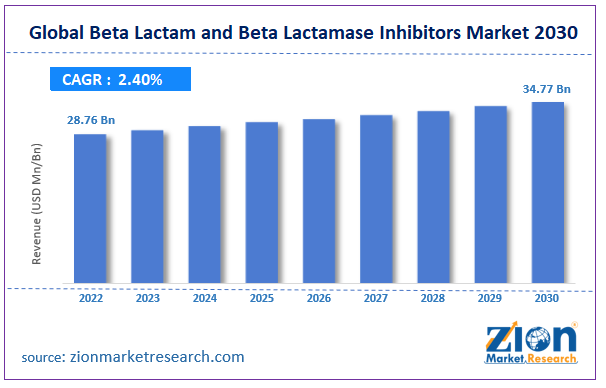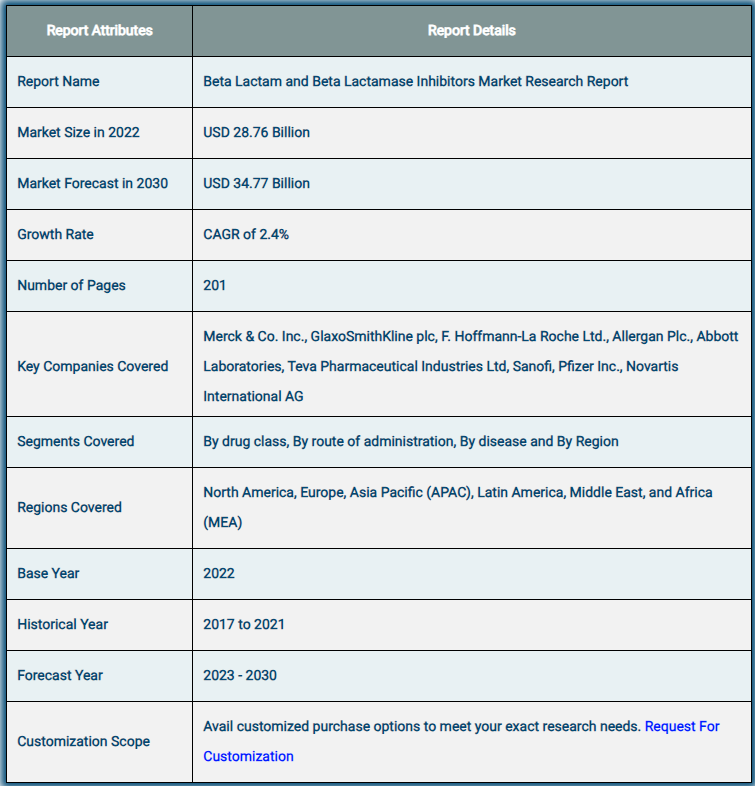Beta Lactam and Beta Lactamase Inhibitors Market Size, Share, Trends, Growth and Forecast 2032

The global market for beta-lactam and beta-lactamase inhibitors was estimated to be worth USD 28.76 billion in 2023 and is expected to grow to USD 34.77 billion by the end of 2032, according to a report released by Zion Market Research. Over the course of the projection period, the market is anticipated to rise at a CAGR of 2.4%. The study examines the factors that will propel growth, provide barriers to it, and affect demand for beta lactam and beta lactamase inhibitors globally throughout the course of the projected period. Additionally, it will aid in navigating and investigating the prospects that present themselves in the market for beta lactam and beta lactamase inhibitors.
✈👉Get a Free Sample: 🚀https://www.zionmarketresearch.com/sample/beta-lactam-and-beta-lactamase-inhibitors-market
Introduction
Beta-lactam antibiotics are among the most widely used antibacterial agents, effective against a broad spectrum of bacteria. However, the emergence of beta-lactamase enzymes, which can hydrolyze and inactivate beta-lactam antibiotics, has become a significant challenge in treating bacterial infections. To combat this resistance, beta-lactamase inhibitors have been developed and are increasingly used in conjunction with beta-lactam antibiotics. This research article explores the current trends, drivers, challenges, and future outlook of the beta-lactam and beta-lactamase inhibitor market.
Overview of the Global Market for Beta Lactam and Beta Lactamase Inhibitors
The global beta-lactam and beta-lactamase inhibitor market was valued at approximately USD 35 billion in 2023 and is projected to grow at a compound annual growth rate (CAGR) of 6.5% from 2024 to 2030. The rising incidence of bacterial infections, coupled with the growing prevalence of antibiotic resistance, drives market growth.
Chemicals classified as natural, semi-synthetic, or synthetic include beta-lactam and beta-lactamase inhibitors. They inhibit protozoans and bacteria. Two classes of antibacterial drugs that are frequently used to treat bacterial infections are beta-lactam and beta-lactamase inhibitors. They are also used to eliminate or prevent the growth of microorganisms. Based on their molecular structure, beta-lactam and beta-lactamase inhibitors are classified into five groups: combination, monobactam, carbapenem, cephalosporin, and penicillin.

Growth Factors for the Global Market for Beta Lactam and Beta Lactamase Inhibitors
The market for beta-lactam and beta-lactamase inhibitors worldwide is expanding rapidly. The main factors driving it are a rise in the prevalence of infectious diseases and increased demand in low- and middle-income countries (LMICs). For example, the World Health Organization reports that acute lower respiratory tract infections have long been one of the main causes of death and disability in both adults and children. Lower respiratory tract infections are the leading cause of death for children under five worldwide, estimated to be responsible for over 4 million deaths annually.
Therefore, there is a growing need for beta-lactam and beta-lactamase inhibitors to combat the significant burden of infectious diseases, which is driving market expansion. Furthermore, the market is being augmented by the creation of innovative methodologies for novel beta-lactam and beta-lactamase inhibitors, which are intended to combat bacterial infections. Additionally, a plethora of clinical research is driving the market’s rise. However, due to the availability of over-the-counter medications, it is anticipated that the market for beta-lactam and beta-lactamase inhibitors will be hindered by the emergence of antibiotic resistance and overuse. On the other hand, throughout the forecast period, the discovery of novel combination treatments and highly promising advanced compounds is anticipated to positively impact the global market for beta-lactam and beta-lactamase inhibitors.

Antibacterial medication became much more necessary during the COVID-19 pandemic. Numerous governments let pharmaceutical companies to develop quick fixes to stop the virus from spreading. During the course of treatment, the need for antibacterial medications doubles as the COVID-19 infected person gets severe bacterial infections. Also, a patient with COVID-19 may experience serious complications from other infectious infections. The need for beta lactam and beta lactamase inhibitors in the global market was raised by all of these considerations.
Market Segmentation for Global Beta Lactam and Beta Lactamase Inhibitors
Based on medication class, mode of administration, ailment, and geography, the worldwide market for beta lactam and beta lactamase inhibitors is divided.
The global drug class market is divided into two segments according to combination, cephalosporin, carbapenem, penicillin, and monobactam.
The market is divided into intravenous, oral, and other categories based on the mode of delivery.
The market is segmented by disease into categories such as blood stream infection, nosocomial pneumonia, respiratory infection, urinary tract infection (excluding complicated urinary tract infection; cUTI), skin infection, complex intra-abdominal infections (cIAI), and others.
✈👉Directly Purchase a copy of the report with TOC: 🚀https://www.zionmarketresearch.com/toc/beta-lactam-and-beta-lactamase-inhibitors-market
Market Scope for Beta Lactam and Beta Lactamase Inhibitors

Regional Analysis of the Global Market for Beta Lactam and Beta Lactamase Inhibitors
In terms of revenue, Asia Pacific dominated the global market for beta-lactam and beta-lactamase inhibitors in 2020, and this trend is probably going to hold true throughout the duration of the forecast. This is brought on by an increase in the prevalence of chronic illnesses, an aging population, an increase in the use of antibiotics, and the easy access to prescription-free over-the-counter drugs. It is anticipated that developing regions like Africa, Latin America, and the Middle East will present the market with profitable growth prospects. The market’s demand may be driven during the forecast period by important factors like the lack of stringent laws or regulatory controls to monitor the sale of over-the-counter medications, the ease with which antibiotics can be obtained without a prescription, the frequency with which infectious disease outbreaks occur, and the growing trend of self-medication.
Key Drivers
- Rising Incidence of Bacterial Infections: The increasing incidence of hospital-acquired and community-acquired bacterial infections is driving demand for effective antibiotics. Beta-lactam antibiotics, often the first line of defense, are critical in treating these infections.
- Growing Antibiotic Resistance: The rise in antibiotic-resistant bacterial strains is a significant public health concern. The development of beta-lactamase inhibitors aims to restore the efficacy of beta-lactam antibiotics against resistant strains, driving demand for these inhibitors.
- Increased R&D Activities: Pharmaceutical companies are investing in research and development to discover novel beta-lactamase inhibitors. This focus on innovation is expected to propel market growth as new combinations are introduced to combat resistant infections.
- Expansion of the Global Pharmaceutical Market: The growth of the global pharmaceutical market, driven by increasing healthcare expenditure and advancements in drug development, contributes to the demand for beta-lactam and beta-lactamase inhibitors.
- Rising Awareness of Antibiotic Stewardship: Healthcare providers are increasingly focused on antibiotic stewardship programs to promote the rational use of antibiotics, driving demand for beta-lactam and beta-lactamase inhibitor combinations.
Challenges
- Regulatory Hurdles: The development and approval process for new drugs, including beta-lactamase inhibitors, is often lengthy and complex due to stringent regulatory requirements, which can hinder market growth.
- High Development Costs: The costs associated with research, development, and clinical trials for new antibiotics and inhibitors are substantial, which can deter investment and limit the introduction of new products in the market.
- Market Competition: The beta-lactam and beta-lactamase inhibitor market is highly competitive, with numerous established players. The intense competition may impact pricing strategies and profitability for new entrants.
Market Segmentation
The beta-lactam and beta-lactamase inhibitor market can be segmented based on product type, application, and region:
- By Product Type:
- Beta-Lactam Antibiotics (e.g., Penicillins, Cephalosporins, Carbapenems)
- Beta-Lactamase Inhibitors (e.g., Clavulanic Acid, Sulbactam, Tazobactam)
- By Application:
- Hospital-acquired Infections
- Community-acquired Infections
- Surgical Prophylaxis
- Others
- By Region:
- North America
- Europe
- Asia-Pacific
- Latin America
- Middle East & Africa
Regional Insights
- North America: The North American market is driven by the high prevalence of bacterial infections and antibiotic resistance. The U.S. is a significant contributor, supported by advanced healthcare infrastructure and strong R&D activities in the pharmaceutical sector.
- Europe: Europe holds a significant share of the beta-lactam and beta-lactamase inhibitor market, driven by increasing awareness of antibiotic resistance and the presence of major pharmaceutical companies. Countries like Germany, the U.K., and France are leading contributors.
- Asia-Pacific: The Asia-Pacific region is expected to witness rapid growth due to rising healthcare expenditure, increasing bacterial infections, and a growing pharmaceutical industry. Countries like China and India are becoming key players in this market.
- Latin America and Middle East & Africa: These regions are gradually increasing their consumption of beta-lactam and beta-lactamase inhibitors, supported by the rising incidence of infections and improving healthcare infrastructure.
Competitive Landscape
The beta-lactam and beta-lactamase inhibitor market is characterized by the presence of several key players focusing on innovation and product development. Major players include:
- Pfizer Inc.: A leading pharmaceutical company known for its extensive portfolio of beta-lactam antibiotics and combinations, including beta-lactamase inhibitors.
- Merck & Co., Inc.: Merck has a strong presence in the antibiotics market, focusing on research and development of new beta-lactam antibiotics and inhibitors.
- GlaxoSmithKline plc: GSK is involved in developing beta-lactam antibiotics and beta-lactamase inhibitors, emphasizing research and innovation.
- Bristol-Myers Squibb: This company focuses on developing and marketing beta-lactam antibiotics, particularly in combination with beta-lactamase inhibitors.
- AstraZeneca: AstraZeneca has a robust pipeline of antibiotics, including beta-lactam and beta-lactamase inhibitor combinations, targeting multi-drug resistant infections.
Future Outlook
The beta-lactam and beta-lactamase inhibitor market is expected to experience steady growth over the next few years, driven by the increasing incidence of bacterial infections and the urgent need to combat antibiotic resistance. The focus on R&D for novel inhibitors and combinations will likely shape the future of this market. Additionally, raising awareness about antibiotic stewardship and improving healthcare access in emerging markets will contribute to market expansion.
Conclusion
The global beta-lactam and beta-lactamase inhibitor market is poised for significant growth, driven by rising bacterial infections and the challenge of antibiotic resistance. While challenges such as regulatory hurdles and competition exist, the overall market outlook remains positive. Manufacturers that invest in innovation and address the challenges of antibiotic resistance will likely thrive in the evolving landscape of the beta-lactam and beta-lactamase inhibitor market.
✈👉Enquiry for buying: 🚀https://www.zionmarketresearch.com/inquiry/beta-lactam-and-beta-lactamase-inhibitors-market
Find out more👇
Drilling and Completion Fluids Market
Agricultural Films And Bonding Market
Contact Us:
Zion Market Research212
USA/Canada Toll Free: 1 (855) 465–4651
Newark: 1 (302) 444–016611\
Web: https://www.zionmarketresearch.com/
Blog: https://zmrblog.com/
%20Market%20main%20jpg.png)
Comments
Post a Comment